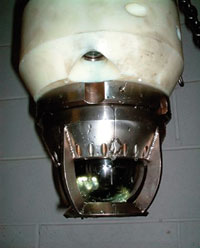 |
United Kingdom |
|
Downhole camera prevents costly contingencies
EV Offshore (EVO) has completed a significant downhole inspection operation in the North Sea for CNR International (UK) Ltd. As CNR prepared to re-open one of its wells for production on Banff field this summer, engineers reviewed the previous end-of-well report. It indicated that metallic debris could be evident on top of the tubing hanger, prohibiting the latching of the tubing hanger running tool for intervention purposes. In addition, it said that the primary sealing area for the tubing hanger running tool could be damaged due to previous cleanout operations. To reinforce its planned contingencies, the engineers had to see what was going on downhole.
 |
Downhole camera and side-mounted auxiliary camera.
|
|
CNR discussed carrying out a downhole inspection with the CamScan EVO2, a camera inspection system designed to inspect conditions visually downhole and subsea. The inspection would be carried out on Transocean’s rig John Shaw to inspect Well B4, 200 km offshore Aberdeen. The area above the tubing hanger crown plug and annular cavity would be inspected. The procedure wasn’t going to be easy, especially in turbid water at depths of 360 ft.
Camera deployed downhole on drill pipe. The initial solution was straightforward: deploy the camera downhole on drill pipe, with the camera running tool (CRT, see photo). This approach would offer full, continuous hemispherical viewing – in color or monochrome – while running downhole. It is also capable of flushing turbid water and dislodging obstructions at target depth to offer a clear view.
Upon further analysis of CNR’s subsea drawings, it was noticed that there would be a blind spot that the camera could not view: the sealing area that would be critical for the primary intervention seal. Fortunately, the camera allowed for an auxiliary camera to be controlled from the same topside control unit. A second camera was mounted on the side of the CRT with its control lead plugged into the auxiliary port on the rear of the camera. Eccentric nylon sleeves were engineered to mount the side camera to provide guidance into the inspection area. The auxiliary camera would provide a direct vertical view into the annulus.
The company presented its engineered solution to CNR, which gave its approval. Mobilization could have been scheduled to take place within just 10 days, so nylon sleeves and auxiliary cameras were built, tested and certified. The equipment was mobilized by boat on July 19, with two trained camera operators flying out the following day.
Flushing turbid water offers clear view. On July 22 at 14:45, the CRT was attached to the drill pipe. Once the CRT was tightened to the required torque, the two nylon sleeves, the CamScan rotate-and-tilt camera and the auxiliary side camera were fitted. All locking security collars and screws were tightened to prevent items from being lost in-hole, and surfactant was applied to the camera viewing domes to disperse and prevent debris from sticking to them. At 15:30 running in-hole commenced. Immediately beneath the rotary table, as the camera entered 18-in. casing, visibility was less than 10 mm due to the turbid water. At 16:05 on the last stand, the top flush assembly was secured to the drill pipe.
Thirty minutes later, with the flush pump in place and visibility still less than 10 mm, seawater flushed the area at 5 bbl/min. Within minutes, the internal features of the crown plug became visible, followed by the debris. CNR engineers surveyed the scene carefully. Armed with an accurate view of the area, they moved forward with a strategy to deal with the obstructions, allowing Well B4 to be re-opened.
By 18:00, EVO had removed the CRT and cleared the drill floor. The operation took just 3.25 hours, including making up the running tool to the drill pipe, running-in-hole, inspection, pulling out-of-hole and breaking down the running tool.
Inspection saves time and money. On completion of the inspection run, a CNR subsea engineer commented, “It was imperative that we obtain an accurate visual in order to plan and execute our contingencies with a high degree of confidence. Fortunately, EVO was able to adapt the CamScan with a maneuverable auxiliary camera, and provide jetting ports for clear downhole video footage.” Jack McKinley, offshore installation manager for Transocean, said, “EVO provided us with the perfect solution to a complex problem using an impressive piece of technology.” 
|




